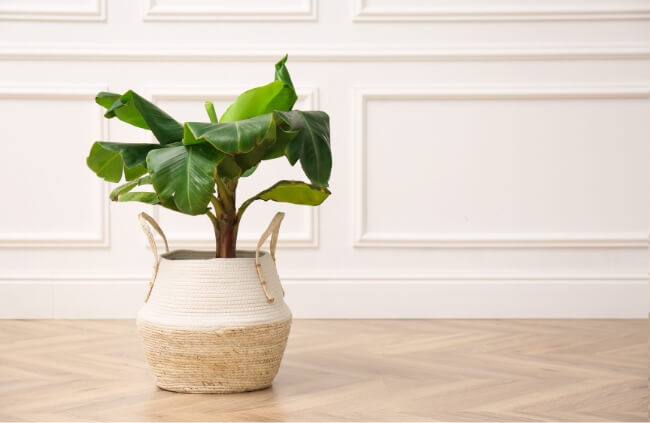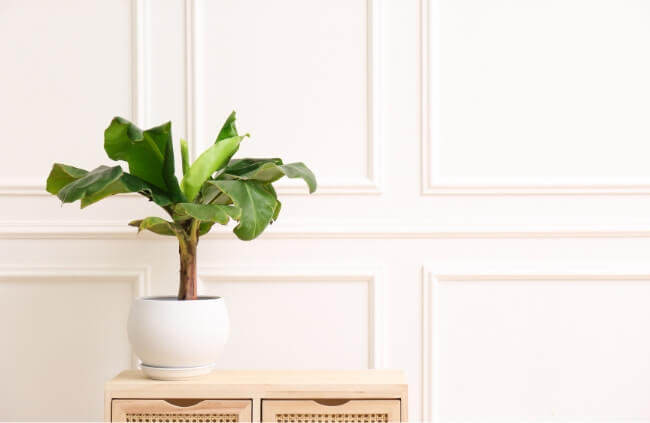Banana plants thrive in tropical regions, but you can grow banana plants indoors even if you do not live in a warm area. With their large leaves and white flowers, the trees make attractive houseplants and add a touch of the tropics to your decor.
Before you make a purchase, you should decide which of the many types of banana plants will suit your needs. If you want to grow bananas, choose a fruit-bearing variety. Indoor banana plants require plenty of light and the proper soil mixture, but with special care and attention, these fast-growing perennials will thrive in your home.
More...
Indoor Banana Plant Varieties
Because indoor banana plants grow very tall, consider buying dwarf varieties, which generally grow to a maximum height just under 2 metres. Dwarf varieties include the Chinese Yellow, Dwarf Red and Cavendish. Super Dwarf varieties grow to 1 metre in height.
Best Conditions for Growing Banana Indoor

Sunlight and Temperature
Choose a bright location for your plant, since indoor banana plants require about 12 hours of indirect sunlight a day. Fruit-bearing banana plants will not produce fruit without sufficient sunlight.
Night temperatures should not drop below 20°C, and daytime temperatures should stay in the high 20s. Temperatures below these levels may stunt the plant’s growth, and freezing temperatures will kill them.
Choosing the Right Growing Container and Soil
When choosing a pot, you should consider the eventual height of the plant and the fact that the roots will need plenty of room to spread out in order to grow bananas. If you start out with a small container, prepare to re-pot your plant as it grows.
The container should provide good drainage and allow you to dig a hole double the width of the root system to a depth of 45 centimetres. Add 5 centimetres of gravel to the bottom of the hole to prevent standing water around the roots.
Add 5 to 10 centimetres of high-quality porous commercial potting soil, and place the banana plant in the hole.
Add more soil, patting it firmly around the roots of the plant. Mulch with organic compost to a depth of 5 to 10 centimetres, and irrigate the plant until water runs out the drainage holes.
Watering Indoor Banana Plant
Indoor banana plants require more water than their outdoor counterparts, but do not over-water. (Check out our guide to growing banana trees outdoors to see the difference in growing approach.)
Insert a finger into the soil to determine if the plant is dry. If the soil feels moist, the plant does not need additional water. If the top 2 centimetres of the soil feels dry, it is time to water the plant. Indoor banana plants usually require watering every other day during warm months.
During the cold months, reduce watering to as little as once a month. Keep the plant properly hydrated by occasionally misting the leaves.

Fertilising Indoor Banana Plants for Fruit Production
Banana plants require regular and frequent feeding, especially during warm weather months, when they grow more rapidly. Fertilise once a month with a balanced liquid fertiliser during growing months to grow bananas. Stop fertilising during winter to scale back growth and allow the plant to gain strength for the next year’s growth.
It takes considerable time for banana plants to flower and produce fruit. If you plan to grow bananas, count on keeping the plant in the same spot under the same conditions to allow it to flower within two years of planting. Harvest bananas when they are plump, with no visible ribs.
Cut the bananas a good distance above the fruit to avoid damaging the growing stalk. Enjoy the result of your efforts to grow bananas with naturally ripened fruit both delicious and full of vitamins.
Treat Banana Plant Pests Promptly
A common problem encountered by indoor banana plants is infestation with spider mites and scales. Spray the pests on leaves and stem with soapy water to eliminate them.
Act at the first indication of a problem, since spider mites will suck the sap from the leaves and possibly destroy the entire plant. Apply insecticide if the soapy water spray does not work.
Published on June 8, 2023 by Gary Clarke
Last Updated on October 25, 2023




